NVIDIA GeForce GTX 670 Review Feat. EVGA: Bringing GK104 Down To $400
by Ryan Smith on May 10, 2012 9:00 AM ESTCompute
Shifting gears, as always our final set of benchmarks is a look at compute performance. As we have seen with GTX 680, GK104 appears to be significantly less balanced between rendering and compute performance than GF110 or GF114 were, and as a result compute performance suffers. Cache and register file pressure in particular seem to give GK104 grief, which means that GK104 can still do well in certain scenarios, but falls well short in others.
Our first compute benchmark comes from Civilization V, which uses DirectCompute to decompress textures on the fly. Civ V includes a sub-benchmark that exclusively tests the speed of their texture decompression algorithm by repeatedly decompressing the textures required for one of the game’s leader scenes. Note that this is a DX11 DirectCompute benchmark.
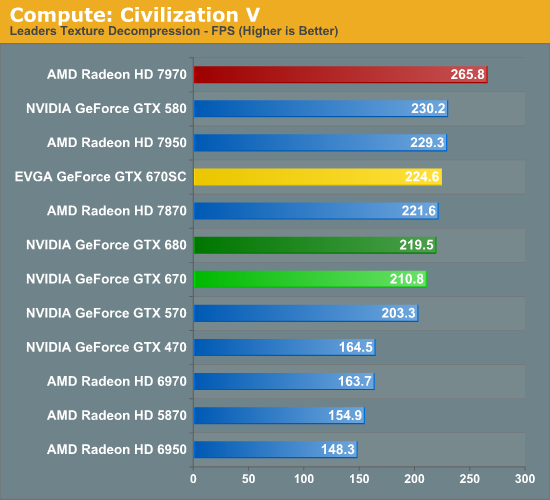
It’s quite shocking to see the GTX 670 do so well here. For sure it’s struggling relative to the Radeon HD 7900 series and the GTX 500 series, but compared to the GTX 680 it’s only trailing by 4%. This is a test that should cause the gap between the two cards to open up due to the lack of shader performance, but clearly that this not the case. Perhaps we’ve been underestimating the memory bandwidth needs of this test? If that’s the case, given AMD’s significant memory bandwidth advantage it certainly helps to cement the 7970’s lead.
Our next benchmark is SmallLuxGPU, the GPU ray tracing branch of the open source LuxRender renderer. We’re now using a development build from the version 2.0 branch, and we’ve moved on to a more complex scene that hopefully will provide a greater challenge to our GPUs.
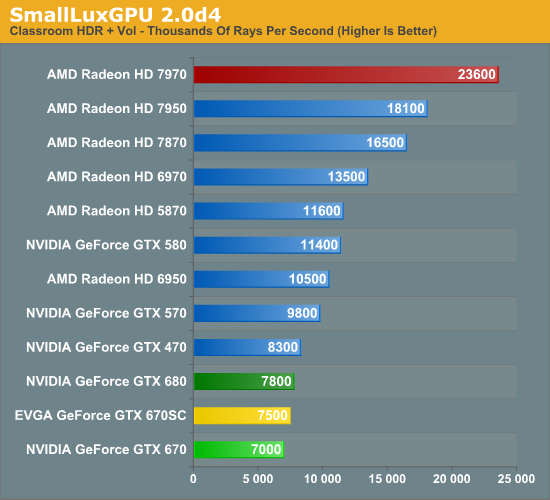
SmallLuxGPU on the other hand finally shows us that larger gap we’ve been expecting between the GTX 670 and GTX 680. The GTX 680’s larger number of SMXes and higher clockspeed cause the GTX 670 to fall behind by 10%, performing worse than the GTX 570 or even the GTX 470. More so than any other test, this is the test that drives home the point that GK104 isn’t a strong compute GPU while AMD offers nothing short of incredible compute performance.
For our next benchmark we’re looking at AESEncryptDecrypt, an OpenCL AES encryption routine that AES encrypts/decrypts an 8K x 8K pixel square image file. The results of this benchmark are the average time to encrypt the image over a number of iterations of the AES cypher.
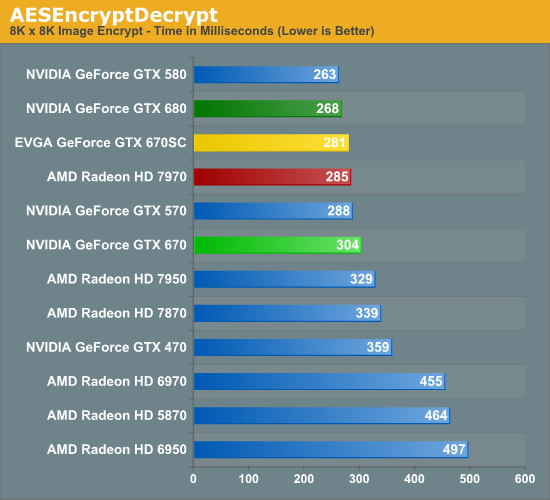
Once again the GTX 670 has a weak showing here, although not as bad as with SmallLuxGPU. Still, it’s enough to fall behind the GTX 570; but at least it’s enough to beat the 7950. Clockspeeds help as showcased by the EVGA GTX 670SC but nothing really makes up for the missing SMX.
Our foruth benchmark is once again looking at compute shader performance, this time through the Fluid simulation sample in the DirectX SDK. This program simulates the motion and interactions of a 16k particle fluid using a compute shader, with a choice of several different algorithms. In this case we’re using an (O)n^2 nearest neighbor method that is optimized by using shared memory to cache data.
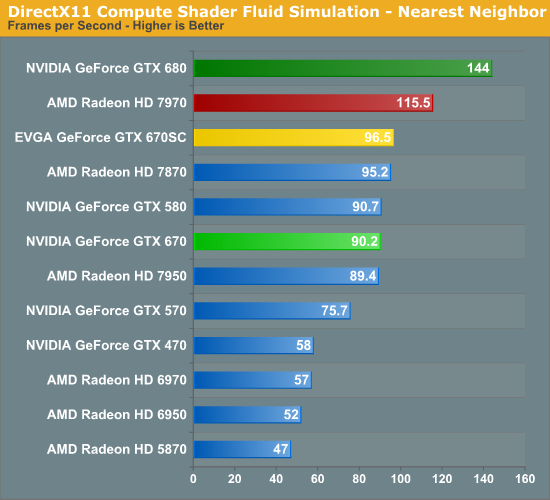
For reasons we’ve yet to determine, this benchmark strongly dislikes GTX 670 in particular. There doesn’t seem to be a performance regression in NVIDIA’s drivers, and there’s not an incredible gap due to TDP, it just struggles on the GTX 670. As a result performance of the GTC 670 only hits 42% of the GTX 680, which is well below what the GTX 670 should theoretically be getting. Barring some kind of esoteric reaction between this program and the unbalanced GPC a driver issue is still the most likely culprit, but it looks to only affect the GTX 670.
Finally, we’re adding one last benchmark to our compute run. NVIDIA and the Folding@Home group have sent over a benchmarkable version of the client with preliminary optimizations for GK104. Folding@Home and similar initiatives are still one of the most popular consumer compute workloads, so it’s something NVIDIA wants their GPUs to do well at.
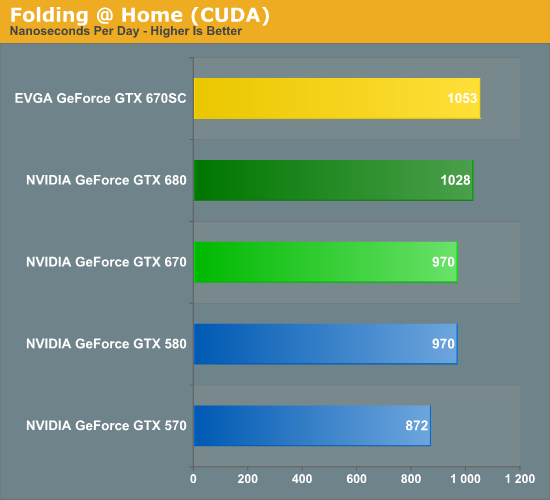
Whenever NVIDIA sends over a benchmark you can expect they have good reason to, and this is certainly the case for Folding@Home. GK104 is still a slouch given its resources compared to GF110, but at least it can surpass the GTX 580. At 970 nanoseconds per day the GTX 670 can tie the GTX 580, while the GTX 680 can pull ahead by 6%. Interestingly this benchmark appears to be far more constrained by clockspeed than the number of shaders, as the EVGA GTX 670SC outperforms the GTX 680 thanks to its 1188MHz boost clock, which it manages to stick to the entire time.










414 Comments
View All Comments
CeriseCogburn - Friday, May 11, 2012 - link
Here we are treated to 5 paragraphs of attack on the 600 series, note the extreme phrasing given against, the "known problem" of the GTX cards, not the "inexplicable" results that means something is wrong other than with the amd card when it loses.This contrasts with the bland put downs the 670 compared to the 680 and 570 receive when they win by enormous comparative margins in the rest of the game pages.
So the reviewer has a field day here:
" Overall performance isn’t particularly strong either. Given the price tag of the GTX 670 the most useful resolution is likely going to be 2560x1600, where the GTX 670 can’t even cross 30fps at our enthusiast settings."
Completely unmentioned of course after the jab at pricing just for the 670, same price as the 7950 that fares not playably better here and gets spanked the other 75% of time, is the 5760x1200 higher resolution where the 670 achieves even higher frame rates than 30, surpassing 30 all the way up to 35.6, just below 35.8 for the 7950, two tenths of one frame.
Somehow, that isn't mentioned, only the lower 2560 resolution with lower frame rates (for all the cards) but the 670 singled out as the only card that has peaked at "given the price".
Later in the review completely unplayable frame rates for all cards in a test is used to attack just the 570, too, for lack of memory. Forget the fact that none of the other cards had playable frame rates.
Eye candy was turned down at the triple monitor resolution but that has never before made 2560 most useful for reviews here, especially with lower frame rates for all the cards tested at the lower resolution settings. Only when we can cut down nVidia is such a statement useful, and it is very definitely confined to just the nVidia card then.
So avoided is the paltry frames of the other competing cards even at "easier" 5670 settings.
If the 670 is no good past 2560, then neither are any of the other cards at all, except the 7970 ? Maybe the reviewer suddenly has decided 5670 gaming is no good.
" Even 1920x1200 isn’t looking particularly good. This is without a doubt the legitimate lowpoint of the GTX 670. "
Well, then the 7950 doesn't look good at 1920 either, less than 1 fps difference, not to mention the 680 that is within in couple frames.
If we take the reviewers words with their total meaning, what we have is the unsaid statement that - only possibly the 7970 should be used for this game at 5670, no other card though.
Now - a total examination of the Crysis Warhead gaming page fps charts reveals this:
Every card is unplayable at every resolution except for the latest respective releases in 1920X1200 chart.
BrunoLogan - Friday, May 11, 2012 - link
... still unreachable for me on what budget is concerned. The 660Ti is what I'm looking for but as I saw somewhere it may be 5 or 6 months away and I don't know if I can wait that long. My old C2D need's replacement. I may just grab a 560Ti and later down the road get 760Ti skipping 6xx generation... bittersweet :-\
shin0bi272 - Friday, May 11, 2012 - link
what gpu do you have now? You said you need to upgrade your core 2 cpu but didnt say what you have for a gpu.Im still running a gts 250 and getting pretty good fps on everything but BF3 at pretty high specs on a 19x12 monitor. Your major issue with games today is they are made for consoles with dx9 cards in them that came out in 2006. So with some exceptions (crysis, metro 2033, and bf3 for example) you dont really need a huge card for anything other than playing all the new games at max spec. Sure everyone wants to do that but you dont necessarily NEED to. I played metro2033 and had physx on and it was easily playable in the 30-40 fps range.
So if you upgrade your cpu (which btw you really only need to upgrade to a quad core if its a gaming rig to get the max fps a cpu upgrade wil give you) and keep your current gpu and then when money allows grab a 670 or 685 or whatever AMD has to offer in your price range.
BrunoLogan - Friday, May 11, 2012 - link
Do you really want to know? I have a 9600GT :-P Also, I can't call it an upgrade as in "adding some new parts and keeping some of the existing ones". I'm really buying a new machine PSU and tower included. That's why I say it's bittersweet to buy a new machine with previous generation graphics.shin0bi272 - Monday, May 14, 2012 - link
hmmm well see what you have for cash left over after buying the important parts. Honestly buying a new system now is a good idea. Ivy bridge being released which drops the prices of sandy bridge (which as I said before will give you the same FPS in game) and even throwing $125 at a 550ti will be a good jump till the end of summer when the 685 comes out, and the 550 wouldnt give you the best fps so youd still be wanting to upgrade.shin0bi272 - Monday, May 14, 2012 - link
oh and a gts250 is a rebadged and die shrunk 8800gtxmedi01 - Saturday, May 12, 2012 - link
Hard to justify buying 560Ti, unless you somehow decided to only by nVidia.7850 consumes much less power while being ahead performance wise.
CeriseCogburn - Saturday, May 12, 2012 - link
7850 costs more, and has the massive disadvantage of being plagued with the now featureless in comparison amd crash pack latest, 12.4, to be followed on by another disaster within a months time.medi01 - Sunday, May 13, 2012 - link
Why don't you kill yourself, dear nVidia zealot with a lot of time to post utter nonsense?CeriseCogburn - Sunday, May 13, 2012 - link
LOL - hey man the facts aren't issues to be sad about.If I get depressed I'll let you know so you can help. :)